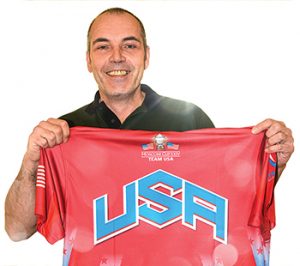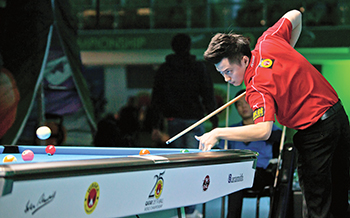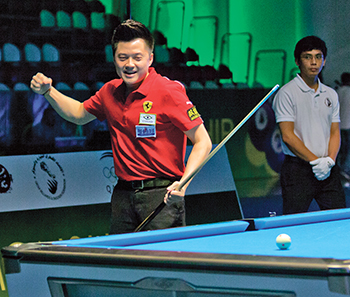Jumping to Conclusions
Forty years after its creation, the jump cue is still a controversial topic, although its impact on the game can’t be disputed.
By Keith Paradise
Playing in the semifinals of March’s Predator World 10-Ball Championship in Las Vegas, former world champion Fedor Gorst found himself in a difficult situation.
With the 9 ball blocking his path to the 5 ball near the corner pocket, he grabbed his jump cue and swiftly popped the object ball into the corner pocket. After landing the ball, the cue ball rolled behind the 8 and the Russian, with the jump cue still in hand, quickly jumped over the obstruction and rolled the 6 ball into the side pocket with a slight cut shot. Again, the cue ball refused to cooperate, now drifting behind a 10 ball that now blocked his path to the 7. Gorst once again used the black carbon fiber cue to pocket the 7 on a bank shot but this time scratched in the far corner pocket, as the crowd at the Rio All-Suites Hotel and Casino groaned at the misfortune before ultimately cheering the performance they had just witnessed.
Sanchez Ruiz held on for the win, but Gorst walked away with one of the most talked about moments in the tournament.
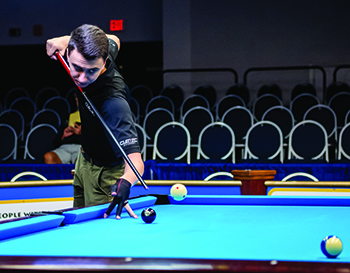
Forty-years ago—even 20 years ago—if you wanted to watch professional pool players sending cue balls airborne to pocket balls like this there was a better than good chance you were probably tuning into “Trick Shot Magic” on ESPN, a series of televised trick shot competitions promoted and aired on the network. But as cue manufacturers have continued to introduce jump cues into the professional game, players have developed a proficiency with the tool to the point that being able to jump accurately has become as critical a skill to learn as breaking and position play.
Over four decades after its almost accidental creation, the jump cue has slowly grown to become the third cue that virtually every professional player carries in their case.
“I think the top players are starting to get it,” said Gorst in a phone interview from the Philippines. “Five years ago, it was more about who was breaking better. But now, since they’re changing the break and rack formats, it leads to a lot of safety battles where you have to jump.”
“The jump is becoming more and more a really big part of the game,” said Billiard Congress of America Hall of Famer Ralf Souquet. “Because of the new equipment over the last five to 10 years, if you’re a certain height and if your fingers are long enough, you can jump quite easy. I’m not saying you’re going to make the ball but you’re going to clear the object.”
As is usually the case with new technology in any game—such as the hybrid club in golf—acceptance and proficiency at the pro level has now trickled down to the amateur ranks as well. Not surprisingly, the increase in demand had led to more manufacturers making and selling the sticks. According to Kyle Nolan, product development lead at Cuetec, the brand’s jump cue sales have grown by more than 50 percent year after year for the past four years. Online retailer Pooldawg currently has 24 jump cues for sale from approximately 10 different manufacturers, with many of the higher priced carbon fiber models made by Predator and Cuetec currently out of stock.
“I was pretty surprised by it too, but we have a really hard time keeping the carbon fiber jump cues in stock,” said Keven Engelke, General Manager for the popular online retailer. “When we have them, they definitely are moving.”
Even some professional players are getting into the action, with brothers and former world champions Ping Chung and Pin Yi Ko developing their own line of jump cues which were introduced onto the market in the last couple of years.
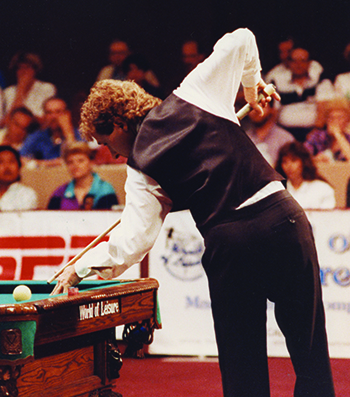
Jump cue technology has come a long way since the “short sticks“ used by Nick Varner in the early ’90s.
“Because we practice our jumping every day, we can jump a little bit better than the average player,” said Ping Chung, former World 10-Ball Champion, in a text message. “It was because of this reason that we wanted to do our own jump cue.”
While the cue started as a tinkerer’s invention and evolved into a staple in the artistic pool industry before ultimately becoming entrenched in the pocket billiards game of the 21st century, the jump cue is not without controversy. Of all the modern inventions that have been created over the last half century designed to make the game easier—carbon fiber shafts, low-deflection shafts, break cues and composite tips—the jump cue might be the one that has created the most debate, with some promoters and leagues still prohibiting them four decades after their invention.
Regardless of the variance of opinions, the game is more three-dimensional than it has been in the last 100 years, and with the recent improvements that have come on line in recent years, shots like what Gorst pulled off in Las Vegas might only be the beginning of what’s to come.
Pat Fleming was messing around with a masse cue on his home table around 1981, attempting to curve the cue ball around a blocking ball towards his target.
While attempting to shoot around the nuisance sphere, he watched as the cue ball jumped over the ball instead. He stood there for a moment puzzled. Why did it go over when he wanted it to go around? More importantly, he wondered if he could make it happen again. And so, he tried it and it did. And then again. And again.
“All of the sudden, I realized that I could jump balls with this cue,” said Fleming.
He took it to Long Island cuemaker Pete Tascarella, who was just starting his cue-making operation after acquiring the late George Balabushka’s equipment, and asked him to build an extension for this cue out of lightweight balsa wood. Fleming then headed to Florida where he used his invention in a tournament.
“I was jumping balls like crazy and, of course, no one had seen this before,” said Fleming. “Then I started using it everywhere that I went.”
Conversely, Tascarella saw what Fleming was able to do with the shortened cue and developed a breaking cue that would disengage about halfway between the joint and the butt end, one of the earliest models of a jump-break cue. He made and sold a handful and a friend suggested he patent the design, but he sold such a limited volume of cues he didn’t think it was worth the energy.
Meanwhile a time zone away, Sammy Jones had perfected getting a ball airborne simply with the shaft of his two-piece cue, becoming proficient at gambling games which involved him playing with or executing jump shots with the top half of his cue. Gambling and hustling in the South in the early 1970s, Jones had mastered the art of coming up with gimmick games to win money. He eventually perfected a trick shot over time where he could jump an entire rack of balls with the shaft.
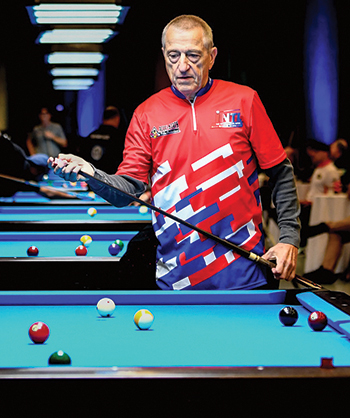
Fleming was simply testing a masse cue when he realized how easy it made jumping balls.
“It was kind of a neat feeling to be able to do that,” said Jones. “Not everyone could do it because no one really knew what it was all about.”
When Fleming learned of this skill, he assumed that Jones had developed some sort of trick shaft that could vault a ball over a blocker. When he was in Kentucky a few months later for a tournament and ran into Jones, he asked him about this rumor that he had heard. After Jones confirmed the rumor, Fleming waited for him to pull out some contraption from hie case. Instead, Jones asked to borrow Fleming’s shaft and casually jumped the cue ball over an object ball.
By now, he had picked up the nickname “Jumpin’ Sammy Jones,” eventually having a handle made for the shaft that he would use in competition. He slowly noticed that the crowd clapped for certain things during a match, such as a pocketed 9 ball on the break and when he made a jump shot with his new contraption.
“So, this was pretty cool,” said Jones. “And then everyone started getting a jump cue.”
Well, not everyone.
At this time, only Jones, Fleming and fellow player Dave Bollman, an employee at Q-Masters in Norfolk, Va., who also built cues, were the only competitors carrying a dedicated cue for jumping. As is usually the case when someone comes out with something unconventional, there was some backlash, most notably from Earl Strickland, who had developed his own technique for jumping balls with his playing cue. In fact, one of the most memorable shots of Strickland’s young career occurred when he executed a jump shot against Steve Mizerak in the final of the 1983 Caesars Tahoe Classic which was broadcast on ESPN.
Fleming recalled arriving at one of the U.S. Open 9-Ball Championship tournaments at Q-Masters and being approached by Jimmy Reid and a handful of fellow players. They had decided that Fleming could use his cue, as long as everyone else could as well. By the late 1980s and into the early 1990s, a handful of jump cues were hitting the market, although many of them were cues in name alone. Some were simply a wooden dowel with a hardened tip on the end, some were short aluminum rods and a couple resembled miniature baseball bats. Since there were no specifications outlined by the Billiard Congress of America or the fledgling World Pool-Billiards Association, there was not a true limit on what could and couldn’t be qualified as a jump cue. After visiting the 1994 BCA Trade Expo, Billiard Digest writer Mike Shamos reported the following:
“Among the most popular products at the BCA Trade Expo were jump cues. They came in all shapes and sizes, from a short six-ounce model that felt like balsa wood to an imposing black aluminum monster with 19-millimeter tip that resembled a cattle prod.”

Before jump cues were common, “Jumpin’s Sammy” Jones gambled using just the shaft.
In the same article, Shamos reported that the Professional Billiards Tour, then the preeminent men’s series, had recently outlawed the cue, while the Women’s Professional Billiards Association had never allowed them in the first place.
“In my opinion, that was very short-sighted,” said Jones. “First and foremost, it’s a great shot and especially to be able to sell another product in the industry. I’ve always been an entrepreneur at heart. It just didn’t make any sense that great players didn’t want to learn that shot.”
And the sticks were popular, especially with the public at trade shows. While developing his trick shot demonstration in the mid-1980s, Tom “Dr. Cue” Rossman would use one of the early jumpers developed by Gene Albright called the Kangaroo Cue, which was about 16 inches long and about 20 millimeters at the tip—a tip he told the crowd was “nitrogen gas-injected” to jump balls. He collaborated with a Minnesota inventor named Brad Boltz on his own line of cues, naming the product the Happy Hopper and inscribing a small rabbit on the butt end of it. He started ending his shows with a trick shot where he lined up a row of balls and jumped them over another line of balls into the side pocket, then told the crowd that they too could have a Happy Hopper for $225.
“Tom’s wife pulls out like a gym bag underneath and they sell like 30 of them in five minutes,” said John Barton, founder of JB Cases, who caught Rossman’s act at a BCA event. “And I mean, people can’t pull their money out fast enough.”
“It was an amazing income that we had off of these cues and, all of the sudden, everyone in the industry was coming to the booth and we sold out of them,” said Rossman.
Barton had his own jump cues for sale at his booth and began playing around with it after seeing Rossman’s act. He developed a new flared-handle cue with German cue makers Hans Joerg Bertram and Oliver Stops and a jump routine of his own. Soon, Barton’s Bunjee line was available for sale at the same shows, with Barton executing a similar series of shots during a demonstration.
The jump cue that might be the most notable of the era was The Frog, a product that was designed by a southern California mechanic and inventor and given to Robin Dodson to try out while she was practicing one afternoon at her home pool room. A two-time World 9-Ball Champion, Dodson didn’t even know how to jump a ball until she was taught how to properly use the stick.
“As soon as I jumped a ball I was like, ‘Oh my goodness, this is a game-changer,” she remembered.
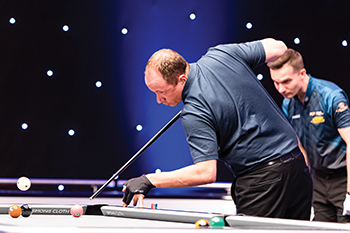
Today’s players, like Shane Van Boening, jump with pocketing and position accuracy.
When she was able to secure a manufacturer who could mass produce the cue, she was given the rights to the product and began selling it at her booth and advertising it in publications. A naturally charismatic saleswoman, Dodson was soon earning more at her pro shop booth at tournaments than she was in the competition, sometimes taking home $30,000 in a weekend. Over time, she found herself wanting her matches to be completed sooner so she could get back to the booth.
“We would bring 500 jump cues and come home with maybe 100,” said Dodson. “I mean, it’s crazy but I just sold it.”
In 1994, members of the Billiard Congress of America’s board of directors met in Arlington Heights, Ill., site of that year’s World 9-Ball Championship and debated rules and specifications for the cue and chose Dodson’s Frog as the template for standard length: It must be at least 40 inches. A standard that stands to this day in the rulebooks.
“It had the most prominence as a jump cue at that time because Robin did a little more advertising and it was probably the best-known jump cue,” said John Lewis, a BCA employee at the time. “We didn’t want to disallow it and so from then on, 40 inches is what they went by.”
Although cuemakers and inventors were coming to market with jump products, not all of them could do the job, whether it was due to having too narrow of a shaft diameter, weight distribution or tip softness. Some were simply shafts with short handles. When Dodson gave demonstrations at her booth to try and teach customers how to jump, she would have the customers dig out their own jump cue to try first to see if it worked. If theirs worked as well or better than hers, she told them. What she found was that some of them couldn’t lift a cue ball at all.
“The function of the cue has a lot to do with tip hardness and leather tips just frankly aren’t hard enough,” said Brandon Jacoby, who has been involved with his father’s Jacoby Custom Cue company for 30 years. “There were a lot of cues on the market that didn’t function really well because they just didn’t have a hard enough tip.”
When the extremely hard phenolic tip was created and installed about 25 years ago, suddenly almost anything had a jumping capability.
“Everything about that tip changed the jump shot, in my opinion,” said Dodson, who eventually transitioned to teaching the jump shot before retiring from competition in 2002. “The fall of the Frog was the phenolic tip because once everyone had that, then their jump cues were nicer.”
“You could put a phenolic tip on a broom, and you could jump with it,” said custom cuemaker Ned Morris, who chose instead to experiment with a hardened leather tip since the chemical compound had the ability to potentially damage balls.
After creating the type of tip he preferred, Morris developed the first three-piece jump cue—a device that Mike Massey used to win a handful of artistic pool championships—then partnered with Stealth to create the Air Time 1 cue around 2000, with Morris estimating that the item sold around 15,000 units overall.
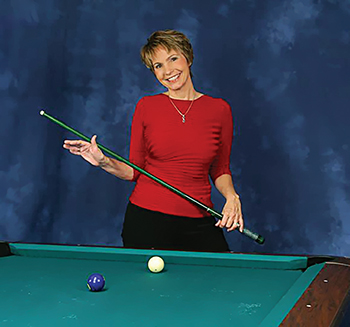
Dodson pocketed more selling her “Frog” than from winning titles.
Early in the 21st century, with the Pro Billiards Tour no longer in operation and the WPBA loosening their prohibition, production cuemakers took a bigger interest in the product, realizing it was yet another piece of equipment that could be marketed to consumers. Japanese manufacturer Miki, the company that produces the Mezz and Ignite lines, introduced its first dedicated jump cues the same year and Jacoby collaborating with local cuemaker James Peterson to build the first edition of the Jacoby Jumper in the early 2000s. Around the same time, Predator introduced the original Air series. “When we entered the market, the jump cues that were on the market could jump but they weren’t really accurate because they were heavy with phenolic on the front end,” said Philippe Singer, Vice President of Predator Group. “We put a lot of research into making a jump cue jump better and be accurate. What we found was that it couldn’t be too heavy because if its too heavy you don’t get accuracy on your jumps.” Whereas the early jump cues focused on weight more towards the front of the cue, Predator began engineering sticks that were lighter on the front end, and also experimented with cues made from different materials. According to Singer, the real game changer in terms of accuracy was the development of carbon fiber, which was introduced on the Predator’s Air Rush jump cue about five years ago. According to Singer, the material naturally has more spring than wood and the tube itself is lighter, which helps with weight distribution. “Now it’s a lot easier to pop the cue ball,” said Singer. “Carbon fiber is just a superior material for restitute force, which is the first thing that helps.”
With big name manufacturers like Cuetec and Predator now involved in the creative process, the days of inventors and garage engineers has given way to collaborative efforts between the companies and the competitors they sponsor. When Gorst first picked up a cue stick almost 15 years ago, he could barely get a cue ball into the air. While practicing on a cramped table in the family home in Moscow, he occasionally needed to switch to his Jacoby jump cue out of necessity due to a wall being in the way and slowly increased his proficiency with the shot. Now sponsored by Cuetec and established as one of the best jumpers in the game, Gorst has worked with the manufacturer on the current line of jump cues and offers feedback, as does Florian “Venom” Kohler,” the professional trick shot artist and social media sensation who is also sponsored by the manufacturer. Nolan said that the company seeks feedback from the professional players they sponsor and value their input but that their contributions need to go beyond just having talent. “If they can’t articulate the differences and can only tell you one cue is better than another, you won’t make much progress,” he said. “The key is to maintain your focus and develop a product that elevates the execution for amateur and professional players.”
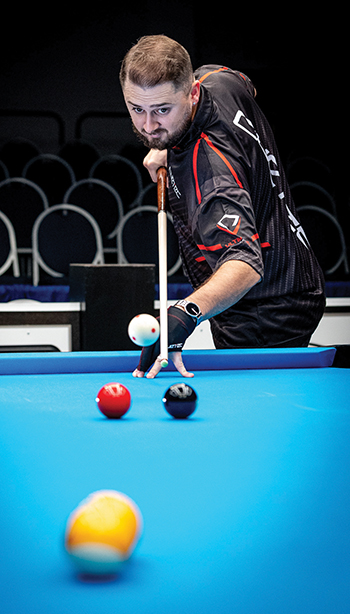
How would a star like Woodward’s game change if promoters and tours still outlawed the jump cue?
This was the objective when the company was working on the current line of Propel jump cues. Cuetec tested the product with professionals and an amateur player focus group and were experimenting with both a 13- and 13.9-millimeter shaft. The pros had little issue with the thinner shaft, but the amateurs kept adding unwanted spin because of the narrower diameter and subsequent smaller sweet spot. As a result, Cuetec proceeded with a 13.9-millimeter model, which Kohler used to set a Guinness world record for longest jump shot (9’1” over two tables).
Singer said the next evolution could be the creation of a line of jump cues that is built specifically with the advanced and recreational player in mind, since both are looking to accomplish different objectives with the shot. A professional player is not only looking to pocket a ball but also control the cue ball for position after the shot, whereas a once-a-week league player who doesn’t practice jump all that frequently is looking for a stick that will simply get the cue ball airborne easier.
“The needs of a pro are not always the same as a league player or the average buyer of the product,” said Singer. “There’s room to answer different needs with different products and segment the market.”
As carbon fiber and engineering have increased the accuracy of these cues over the last decade, the most recent improvement is again with tip technology. Composite tips made of resin and fiberglass, like Tiger’s Icebreaker and the G10, are giving players an additional element of control over their jumps, allowing them to use English and play for position after the shot without sacrificing hardness.
“Jump cues used to be focused on just being easy to jump performance and if it can be used for short jumps,” said Kaz Miki of Miki through email. “People thought that was a good jump cue 20 years ago, but now we are looking for not only easy to jump performance but cuemakers are trying to develop jump cue performance with spin control. Cue ball control is more and more important these days.”
Coincidentally, many of those custom cuemakers who helped create the niche no longer dabble in constructing jump cues. Tascarella is still crafting cues in the same style as the man whose equipment he purchased, but he contends that the man hours and materials involved in making a jump or jump-break cue simply isn’t worth the man hours that could be spent building a playing cue. Morris echoed the sentiment, devoting his time to producing playing cues for his customers.
“I’m just really proud of what I did,” said Morris. “I never knew it would go this far.”
Prideful too are some of pioneers who executed the shot at the table.
“It’s rewarding to watch something that you know you had a part of,” said Jones. “It’s rewarding to see these guys who have really taken it to a higher level. They learn how to aim it from all distances and that’s admirable, in my opinion.”
Although the cues have grown in popularity, it still isn’t an instrument that is universally accepted by league operators and tournament organizers today. The Derby City Classic, Mike Zuglan’s Joss Tour and the American Poolplayers Association prohibit the use of these sticks. Competitors like Dodson and performers like Rossman, who have not only worked with these cues but also marketed them, advocate for their permission with the caveat that the stick doesn’t make the shot; that it still comes down to technique.
“I don’t care how much technology you’ve put in a jump cue I don’t think that’s helped me make the shots,” said Rossman. “I think what has helped me make the shots is the time I’ve spent on the table practicing and learning how to use it.”
Ruijsink to Coach U.S.
Ruijsink replaces Mark Wilson, who helmed the U.S. squad for three years, coming closest to victory in 2015, when the U.S. lost, 11-7.
With Team USA posting just one win in the last 11 Mosconi Cups, Matchroom said it was seeking a game-changer to “revive America’s flagging fortunes,” even if it meant appointing a European coach.
The announcement caught many American players and fans by surprise. Numerous posts on social media decried the decision as “an insult to the Americans,” while others applauded the selection as America’s “best chance” to become competitive again.
“The reason to take on this job is quite obvious,” Ruijsink commented in the Matchroom release. “I am an authentic lover of the game and especially of the Mosconi Cup. In 25 years of coaching, the Mosconi Cup has proven to be by far the most exciting event in the world of pool.
“As a coach in pool, there is no higher goal then working in the ‘home of pool,’ the U.S.A. My entire coaching career has been founded on seeing the American players compete at the World Championships in Bergheim, Germany, in 1990. There I saw Earl, Varner, Davenport, Mizerak, Mataya, Lebron and a young Johnny Archer, and they made me love the game even more.”
Ruijsink is credited with coaching Holland into a pool powerhouse, mentoring stars like Alex Lely, Niels Feijen and Rico Diks in the ’90s and early 2000s. In recent years, he has been coaching in Russia, developing a talented crop of players, including recent World Pool Series champion Ruslan Chinahov.
“I was shocked at first,” said American Justin Bergman, who has played on the last three U.S. squads. “But I don’t think it’s a horrible idea from a player’s view, since he probably has good ideas and he’s a knowledgeable coach. I think we should all support him.”
“I think it’s good, since he was so huge for Europe’s team,” echoed Skyler Woodward, Team USA’s best player over the past two Mosconi Cups.
According to Matchroom, Ruijsink will get to hand pick his five-player team, so long as each player is ranked in the top 10 in Mosconi Cup points in 2017. Additionally, Ruijsink plans to travel to the U.S. several times during the year to meet with and observe potential team members.
Ruijsink’s first decision was selecting Archer as his vice-captian.
Wilson Names Team USA Hopefuls
 As was his original intent, Mosconi Cup Team USA Captain Mark Wilson worked quickly to select the players who will compete for the final five roster spots for the 2014 event in December in Blackpool, England. Wilson announced the selection of eight players who will train and compete together through the summer, before the captain whittles the list down to the five players who will wear the red, white and blue in Blackpool.
As was his original intent, Mosconi Cup Team USA Captain Mark Wilson worked quickly to select the players who will compete for the final five roster spots for the 2014 event in December in Blackpool, England. Wilson announced the selection of eight players who will train and compete together through the summer, before the captain whittles the list down to the five players who will wear the red, white and blue in Blackpool.
Not surprisingly, Wilson tabbed America’s No. 1, Shane Van Boening, and immediately announced that he will expect the taciturn star to provide leadership to the 2014 squad. “Shane sets a great example,” Wilson said in a press release. “And I expect to rely on him for leadership this year.”
Wilson also named seven-time Mosconi Cup veteran Corey Deuel, who many thought should have been on the team in 2013, to the squad. John Schmidt, Oscar Dominguez and Brandon Shuff, each of whom has participated in one Mosconi Cup, were named to the team was well. Leaning on America’s youth, Wilson rounded out his selection with Southern Classic One-Pocket champion Justin Bergman, Derby City titlist Justin Hall and Connecticut’s Jeremy Sossei.
“I’m really excited by this team,” Wilson said. “Every player seems so genuinely appreciative and excited. They’re all willing to do whatever it takes to develop a strong team and a strong sense of unity.”
More interesting than who Wilson selected, of course, was the list of players who weren’t invited to “camp.” The most notable omission was Johnny Archer, whose string of 17 consecutive Mosconi Cup appearances will come to an end. Fourteen-time Cup participant Earl Strickland and nine-time team member Rodney Morris were also left off the roster. In fact, Van Boening will be the only holdover from the 2013 squad that lost 21-1 to Team Europe in Las Vegas.
“I didn’t interview those players,” Wilson admitted. “And I explained to Johnny that I thought it best to go in a completely different direction this year. A lot of it is about attitude. Last year I felt there was no sense of urgency. There seemed to be a sense that it was a yearend bonus, and if the team won, great.”
Another player conspicuous by his absence is Mike Dechaine, one of the most consistent American players over the past three years.
“I spoke to Mike,” said Wilson. “In the end I felt that his reputation among the players wasn’t a good fit at this stage for a team event like the Mosconi Cup.”
Wilson added that his plan is to get the players together several times over the summer and fall for practice and team bonding. Wilson said he planned to make the final cut to five players after the U.S. Open, and that Team USA would meet and practice together for a week at Lindenwood University near St. Louis before departing for London. The dates of the 2014 Mosconi Cup are Dec. 1-4.
U.S. Open Primed for Big Weekend
VIRGINIA BEACH, Va. — Heading into the final two days of the 2012 U.S. Open 9-Ball Championships, it’s clear that the strong have survived. At the conclusion of play on the winners side on Thursday night, just eight players remained. And that octet packed plenty of star power.
Former champions Shane Van Boening, Alex Pagulayan and Johnny Archer are all chasing title No. 2. But in perhaps the most thrilling story of the U.S. Open to this point, 58-year-old Efren Reyes strung together five victories — including an electrifying 11-10 win over two-time defending champ Darren Appleton — to put himself in contention for the Open crown. He will square off against countryman Dennis Orcollo on Friday. Pagulayan and Archer will square off in the other match on that side of the bracket.
Scotland’s Jayson Shaw will face 63-year-old Jose Parica on the other side of the bracket. Parica, runner-up at the 2003 U.S. Open, advanced via a dominant victory over a resurgent Earl Strickland, 11-5. The winner of that set will then face the victor in Shane Van Boening’s match against Ronnie Alcano, a rematch of the 2007 U.S. Open won by the American.
While eight players have two bullets left in their revolvers, the left side is packed with championship-caliber talent. Most notably, late Thursday evening, Darren Appleton trailed American Oscar Dominguez. In search of his third-straight title, the Englishman was struggling to rally in the second match after his heart-breaking loss to Reyes.
Leading the charge on the one-loss side, Japan’s Yukio Akagariyama, China’s Li Hewen and Taiwan’s Chang Jung-Lin are major title winners seeking glory on American soil. Europe’s Albin Ouschan, brother of women’s star Jasmin and rising star on the EuroTour, joins England’s Chris Melling in the title hunt. American hopes settle on Corey Deuel, who dropped a Thursday night set to Jayson Shaw, and five-time titlist Strickland.
IPT World Open Preview: Talented Tots Wu and Ouschan to Debut
The big news in the first round of the International Pool Tour’s latest multi-million dollar 8-ball tournament will be the debuts of young superstars Chia-Ching Wu of Taiwan and Jasmin Ouschan of Austria, both looking for a big piece of the record-setting $3 million purse.
The eight-day 8-ball event — with a precedent-setting $500,000 first-place prize — kicks off Sunday, Sept. 3, at the Grand Sierra Resort and Casino in Reno, Nev.
Both 17-year-old Wu and 20-year-old Ouschan earned entry into the tournament through the IPT’s rugged qualifier process, and they’re expected to go deep. The precocious Wu is the current WPA world 9-ball and 8-ball champion, and Ouschan topped the star-studded field at the EnjoyPool.com 9-Ball Championship in May.
Otherwise, it looks like smooth sailing for most of the favorites in the first round of the International Pool Tour’s World 8-Ball Open Championship, as the just-released groupings reveal predominantly balanced matchups for the first two days of the event. Top-ranked players were seeded in the field.
Of course, a few players had cause for muttering under their breaths when the groups were announced early Friday. Of the best-known players, Hall-of-Famers and best buddies Ewa Laurance and Loree Jon Jones appear to have their work cut out for them. For that matter, the groupings did no favors for Ouschan, the only female player to have won a spot in an IPT field through the qualifier process.
Expect some surprises. As the players learned in the IPT’s first event of the 2006 season — the North American Open 8-Ball Championship in July — there are dozens of unheralded 8-ball whizzes out there waiting for their big shot, and the 200-player World field features 50 qualifiers who have already proved their mettle.
Look for surprising runs from several Asian qualifiers who now have their feet in the IPT’s door, including Wu from Taiwan (who was seeded 16th in the absence of Filipino Rodolfo Luat), and his countryman Hui-Kai Hsia, a two-time world juniors champion.
The first round will feature 40 groups of five players each. After round-robin play, the top three finishers in each group will proceed to the second round. Eliminated players from the first round will each receive a whopping $5,000.
The complete list of groupings is available at the IPT Web site: www.internationalpooltour.com.
Here are some of the more intriguing brackets from the first round:
Bracket 23 — BD Bloodbath Special: Spectators looking for an exciting bracket to follow should check out this group. No superstars, just tough and hungry veterans: Ivica Putnik (Croatia), Thomas Engert (Germany), Tony Chohan (USA), Tony Drago (Malta), and Zlatko Jakulj (Croatia)
Bracket 1: German sensation Thorsten Hohmann received the top seed by virtue of his $350,000 win at the North American Open, joined here by talented American Steve Moore, Filipino toughie Warren Kiamco, and Americans Jim Raney and Loree Jon Jones. Jones, who survived the first round at the North American Open, will have to bring her “A” game here.
Bracket 26: Austria’s Jasmin Ouschan must contend with Hall-of-Famer Earl Strickland, Swedish veteran Tom Storm, Aruba national champion Roland Acosta and American Pete Fusco. Ouschan regularly hones her skills against the best male players in Europe, so don’t expect her to be intimidated by Strickland, or anyone else in the field, for that matter,
Bracket 18: Hall-of-Famer Ewa Laurance will have her hands full with Australia’s Quinten Hann, the snooker bad boy who finished a surprising 18th at the North American Open; snooker ace Ronnie O’Sullivan from the U.K.; and Jeremy Jones (USA) and Jose Parica (Philippines), both experienced champions who met untimely exits at the North American Open. This bracket will be a dog fight.
Bracket 35: Future Hall-of-Famer Allison Fisher, who was undefeated in the first round of the North American Open, once again has a clean look at the second round. But watch out for qualifier Hui-Kai Hsia of Taiwan and surprising Frenchman Yannick Beaufils. Tough Americans Teddy Garrahan and John Ditoro round out the group, and neither will play patsy.
Bracket 10: Once again, 13-year-old Austin Murphy has a good shot at leaving the first round, this time sharing a bracket with 10th-ranked Darren Appleton (U.K.), Paul Potier (Canada), George San Souci (USA) and Ouahbi Amine (Morocco). Murphy missed the second round at the North American Open by a single rack, losing an 8-7 nailbiter to Danny Basavich. Let’s go, Austin.
You Guessed It: Filipinos Reign at First World Cup
The Filipino dream team of Efren Reyes and Francisco Bustamante became the inaugural PartyPoker.com World Cup of Pool champions as they blew away Team USA, 13-5, in front of a packed arena at the Newport Centre, South Wales.
The American duo of Earl Strickland and Rodney Morris were expected to make a match of it, but a combination of bad luck and loose shots on the part of the Americans and unrelenting skill from the Filipinos kept them at bay.
With upwards of 900 people in the arena including a large contingent of expatriate Filipinos, the atmosphere was electric and the tension mounted as the two teams shared the first eight racks of the race-to-13 final.
From there though things unraveled for the Americans. They lost control of the cue ball on the break and consequently found it difficult to get any momentum.
By contrast the Philippines turned up the heat with Reyes in particular playing a series of stunning shots to get out of jail and pot some seemingly impossible balls.
The second half of the match became something of a procession as the Philippines won seven consecutive racks to leave their opponents in no man’s land.
Team USA got one back to take the score to 11-5, but Reyes and Bustamante knocked off the final two racks to take the magnificent silver trophy, the title and a check for $60,000.
“It’s funny that every time there is a new big tournament, I win it, but all week I thought if we could get to the final we can win, said a delighted Efren Reyes after the match.
“The USA is a good team but they were unlucky and that made it easy for us,” he said.
Bustamante was thrilled to take pool’s first ever World Cup event. “In the beginning there was a lot of pressure on us but when we went three games ahead it all lifted,” he said.
“Efren played lots of unbelievable shots; some of them I’ve never seen in my life! That’s why we won.”
For the Americans, Rodney Morris summed up their feelings: “That was pretty disappointing. After 4-4 it didn’t go our way although the match was closer than the score suggested, but when it went to 7-4 we were both pretty deflated and felt it slipping away.”
“We never really got a clear shot off the break and it was a tough hill to climb but they played great – the way they were supposed to, so congratulations to them,” Morris added.
Thirty-one Countries Vie for World Dominance in Wales
National pride is at stake at the PartyPoker.com World Cup of Pool, taking place now at the Newport Centre in Newport, Wales. Pressure is high as the scotch doubles matches are played on a straight knock-out basis.
The first round began on Aug. 22, with 32 two-man teams working together to represent their country. Thailand, represented by Tepwin Arunnath and Amnuayporn Chotipong, fell to Canadians Luc Salvas and Tyler Edey, 9-5. Team Qatar (Fahad Mohammadi and Bashar Hussain) was stymied by Malaysians Patrick Ooi Fook Yuen and Ibrahim Bin Amir, 9-3. And in an inter-continental contest, the Czech Republic, represented by Roman Hybler and Michal Gavenciak, defeated Poland’s Radoslaw Babica and Mariusz Roter.
The Phillipines, represented by Efren Reyes and Francisco Bustamante, were the clear crowd favorites, and rose to the occasion in round one, with a 9-0 massacre over Malta’s Tony Drago and Alex Borg. It was a tight battle between Taiwan’s Wang Hung-hsiang and Yang Ching-shun and India’s Dharminder Lilly and Alok Kumar. The tiny island nation prevailed, 9-6.
England has two teams in the running, one of which is represented by Steve Davis and Daryl Peach. It was 5-5 before the Brits were able to pull ahead of Jeong Young-hwa and Lee Gun-jae of Team Korea. On Davis’ 49th birthday, he joyously accepted their 9-6 victory.
In the second day of play on Wednesday, Aug. 23, Russia’s Konstantin Stepanov and Konstantin Zolotilov starved Hungary’s Vilmos Foldes and Gabor Solymosi of opportunities, defeating them 9-3.
Hong Kong produced a heroic performance to stun sixth- seeded Sweden in the biggest shock thus far in the PartyPoker.com World Cup of Pool. Sweden, whose side consisted of former World Championship finalist Tom Storm and former World Championship semi-finalist Marcus Chamat, had been 4-1, 6-2, and 8-5 ahead in the race-to-9. But the Hong Kong pairing of Lee Chenman and Kong Man-Ho showed their character to win the last four racks to secure a place in the final 16.
Team Japan, Maasaki Tanaka and Satoshi Kawabata obliterated Indonesia’s Imran Ibrahim and Ricky Yang, 9-0. While the English “A” team of Ronnie O’Sullivan and Raj Hundal, didn’t have it quite so easy against Spain’s David Alcaide and Rafael Guzman. The crowd was gutted as the duo fell to a fast 4-0 deficit, but had their hopes back up as England got their nose in front at 8-7, but the Spaniards took the final two racks to close out a famous victory.
Team U.S.A. is composed of Rodney Morris and Earl Strickland, who had a decided victory over Singapore. The home team, Rob McKenna and Ben Davies of Wales, disappointed their fan base with a heart-breaking 9-2 loss to Germany (Thomas Engert and Oliver Ortmann).
Today, Aug. 24, three matches are left to determine the final 16. This morning, Ireland had no luck against Finland’s Mika Immonen and Markus Juva, heading home after a 9-5 loss.
The first matches of round two will begin tonight, with No. 1-ranked Phillipines and No. 3-ranked U.S.A. taking on their respective opponents. For up-to-the minute coverage at www.partypoker.com!
Hallelujah: Winners Sing Out as IPT Field Narrows, Grows Richer
Jubilant shouts and the deep thud of cue butts slamming the floor echoed through the Venetian Hotel and Casino on Thursday night as 18 pool players took another step closer to the $350,000 top prize at the $2 million IPT North American 8-Ball Open – and another 18 saw their dreams cut short.
“Haalllloooooooo!” cried Efren Reyes, as he sank the winning 8 in a must-win hill-hill match against Mick Hill of the U.K., and pumped his fists to the ceiling. He punctuated his triumphant shout with a relieved chuckle, as he watched the cue ball come an inch from scratching in the corner.
“YES!” shouted Englishman Darren Appleton, upon hearing that bracket imate Cory Deuel had lost his last match of the day, leaving the door open for his own ascension into the next round.
“Thank you! Thank you! See you tomorrow, everybody! Yiiiii yiiiiiii!” shrieked Ronato Alcano of the Philippines, after his stats were posted on the official scoreboard and he saw that he beat America Dee Adkins for the third sport in his bracket by a percentage point.
After a 12-hour day of round-robin play, the field of 36 players in round four winnowed to 18, who were guaranteed $30,000 each by virtue of advancing to the fifth round of play. Their 18 eliminated compatriots pocketed a none-too-shabby $17,000.
The Filipino contingent continued its dominance and bettered it chances for claiming the championship, placing seven players in the last 18: Reyes, Alcano, Francisco Bustamante, Marlon Manalo, Dennis Orcollo, Alex Pagulayan and Rodolpho Luat.
The U.S. placed three players in the fifth round with Gabe Owen, Larry Nevel and David Matlock. The U.K. is two strong with Appleton and Daryl Peach. Germany’s last two hopes were Thorsten Hohmann and Ralf Souquet. The remaining four players were Evgeny Stalev of Russia, Australia’s Quentin Hann, and Sweden’s Marcus Chamat, and Rico Diks, representing the Netherlands
As the clock rounded 8 p.m., it was gut-check time for several players who had recorded records of 2-2 and needed a win in their final match for a shot at advancing. Players took their turns in front of the tournament’s billboard-sized scoreboard, nervously drawing numbers in the air as they tried to figure out the calculus of the bracket and how they would fare in different scenarios.
Players on the bubble with 2-2 records included Reyes, matched against Hill (1-3); Alex Pagulayan, playing against fellow Filipino Dennis Orcollo (3-1); and Deuel, set against Filipino Marlon Manalo (3-1). Matches that paired players with identical 2-2 records included Frenchman Yannick Beaufils vs. Niels Feijen of the Netherlands; American Earl Strickland vs. Alcano; and Francisco Bustamante vs. Santos Sambajon, both of the Philippines.
American Gabe Owen was stuck in a must-win position from the third match of the day. He faced fearsome Filipinos Bustamante and Sambajon in his first two matches and lost both of them. He needed to win the next three matches to have a hope of advancing.
“I just thought, screw it – just let it go. You only live once, just do it,” Owen said.
He proceeded to beat Reyes, 8-6; then Hill, 8-6; and in the longest match of the fifth set, Ivica Putnik of Croatia, 8-5. Sinking the last 8, he yelled and pumped his fist at jackhammer speed.
“My feet are killing me,” he said afterwards.
One of three Americans left in the field, Owen felt he had a shot at the title. “I feel like 8-ball is my best game, and I’m getting underrated here,” he said. “I’ve been practicing nothing but my 8-ball break for the last six months. Even in 9-ball tournaments, I’ve been breaking from the box. Screw $5,000 for winning a 9-ball tournament when you can win on the IPT.”
Stalev of Russia already knew what he would do with the $350,000. “I promised my friend [IPT member] Fabio Petroni that we would go on a vacation to Hawaii with five girls,” he said.
Stalev was one of the few players whose record was strong enough by early evening to count on advancing. Others were not as lucky.
“The pressure … the pressure … the hunger … I’m so tired,” said the rail-thin Alcano after squeaking by Strickland, 8-7, in their 8 p.m. match. He tossed his cue in the air, caught it and then did a stiff jig as Strickland packed up his cue case and ignored repeated requests for an on-camera interview by IPT staff.
Even countryman Reyes, perhaps the best big-money player in history, felt the pressure and dogged several shots in his 8-7 win against Hill. He often appeared listless and confused, and several observers opined that the rugged, five-match-a-day schedule was getting to the 51-year-old Hall of Famer.
“I don’t feel tired, … I feel the pressure because I’m in danger,” he said. “My opponent played good. Every time he got a shot, he ran out. In the last game, it was too much pressure for me. I didn’t know what to do in the last game. That’s why I was just shoot, shoot, shoot.”
IPT Round Three Complete
LAS VEGAS, Nev. – Despite some strong opposition from European players, including the surprising contingent of English 8-ballers, the always tough Filipinos are dominating the history-making IPT North American 8-Ball Open.
Virtually every Filipino competitor who started in the 200-player field has made it through to the 36-man fourth round of play – nine altogether, including three Pinoy hopefuls who needed to win qualifiers to gain entry to the $2 million tournament.
Leading the pack, as usual, was legendary Efren “Bata” Reyes, whose overall record stood at 12-1 after three days of round-robin play. No less impressive was the ball-control mastery of Filipino Marlon Manalo, who held an identical 12-1 record, along with Germany’s Ralf Souquet and Rafael Martinez of Mexico.
Third-round play began on Wednesday at the Venetian Hotel and Casino with the remaining 60 players divied into 12 groups of five. The top three in each group would advance to the fourth round on Thursday with a guarantee of at least $17,000 in prize money; the eliminated players would collect a still-impressive $10,000 each.
By 9:45 p.m., the lucky 36 were known. Their names follow, grouped by country, with their third-round records:
USA: Dee Adkins, 4-0; Jason Kirkwood, 3-1; Earl Strickland, 3-1; Cory Deuel, 4-0; Shawn Putnam, 3-1; Rodney Morris, 3-1; Larry Nevel, 3-1; Gabe Owen, 2-2; and David Matlock, 2-2.
Philippines: Efren Reyes, 4-0; Marlon Manalo, 4-0; Francisco Bustamante, 2-2; Dennis Orcollo, 3-1; Antonio Lining, 4-0; Rodolfo Luat, 2-2; Alex Pagulayan, 3-1; Santos Sambajon, 2-2; and Ronato Alcano, 2-2.
United Kingdom: Rico Diks, 2-2; Raj Hundal, 1-3; Daryl Peach, 2-2; Darren Appleton, 2-2; Mick Hill, 3-1.
Netherlands: Niels Feijen, 3-1; Alex Lely, 3-1; and Nick Van den Berg, 3-1.
Germany: Ralf Souquet, 4-0; and Thorsten Hohmann, 3-1.
Other countries: Quinten Hann (Australia), 2-2; Ivica Putnik (Croatia), 2-2; Mika Immonen (Finland), 3-1; Sandor Tot (Italy), 2-2; Yannick Beaufils (France), 2-2; Rafael Martinez (Mexico), 4-0; Evgeny Stalev (Russia), 2-2; and Marcus Chamat (Sweden), 3-1.
Here are some highlights from the round:
* The biggest eye-opener for many established players at the Open has been the success of the top competitors on the English 8-ball circuit, including perennial champions Mick Hill and Darren Appleton. Both will compete in the round-of-36.
“Us lads have come to play the top players from around the world, and I feel that we haven’t been given a chance,” said 26-year-old Hill. “The point that us English lads want to get across to everyone, including our own back home, is that we’re playing 8-ball, not 9-ball or straight-pool. … A lot of people don’t realize that the English players play 8-ball.”
Among their strengths are excellent cue ball control and solid stroke mechanics, said observers.
“Those guys shoot very straight, and I can respect that,” said IPT member Ike Runnels.
* Fifteen women started the competition on Sunday, and only former snooker stars Allison Fisher and Karen Corr were given much of a chance to advance. One woman was able to infiltrate the third round, and she was a U.K. native, but no one you might expect.
“I sort of in a way proved a point,” said Sarah Ellerby, who collected dozens of 8-ball titles in England before coming to the U.S. to compete on the WPBA Classic Tour. “…There wasn’t as much attention on me as on the other girls, and that’s fine.
“I’m sure that some of the guys were like, ‘The women won’t do well here,’” Ellerby said. “If I could break better, I feel like I could really make more of a dent. I think the women are capable enough to come here and do well.”
Unfortunately, Ellerby fell into a tough bracket in the third round and finished with a 1-3 record. Knowing she wouldn’t advance, Ellerby immediately left for the Las Vegas airport to catch an 11:30 p.m. United Airlines flight to Chicago. There, she would catch a limo for a two-hour drive to Peoria, the site of the WPBA Midwest Classic, which was starting play Thursday morning.
“I’m going to be very tired,” she said.
* Staying on the English for another moment, sharp observers might note that Raj Hundal advanced with a 1-3 record. It’s no misprint. Hundal was in a bracket with players who posted 4-0 and 3-1 records (Reyes and Strickland), leaving the other three players with 1-3 tallies. Of the three, Hundal had the highest games-won percentage (56.49 percent, just over American Gary Abood’s 55.09 percent), which pushed him into the next round. That 1.4 percent difference was worth at least $7,000.
“I’m in! I’m in!” the burly Hundal screamed upon hearing the results. “I’m freewheeling tomorrow! … I’m the luckiest [expletive] in the world!”
* Another surprise at the end of the day was how many players who were forced to qualify for the event ended up in the round-of-36. The 200-player field offered 50 qualifiers, and no fewer than nine made it into the fourth round. They included Filipinos Luat, Sambajon and Alcano.
* Most of the favorites remained in the running for the fourth round, with one major exception. American Johnny Archer faded in his bracket, finishing with a 1-3 record.

